These sunflowers aren’t a giant variety, but they ARE pretty big, and they really draw the goldfinches. Sunflowers can get so tall and the leaves grow so big.
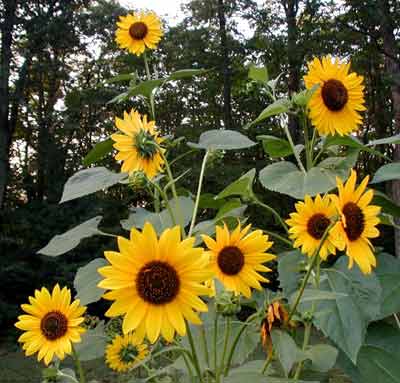
Sunflowers with several large blossoms.
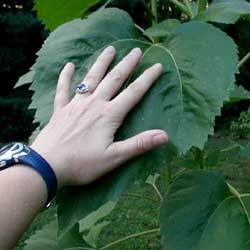
Now that’s a large sunflower leaf!
Dahlias sport many colors, ranging from light, lemony yellow to a salmon red and a variegated purple and white.
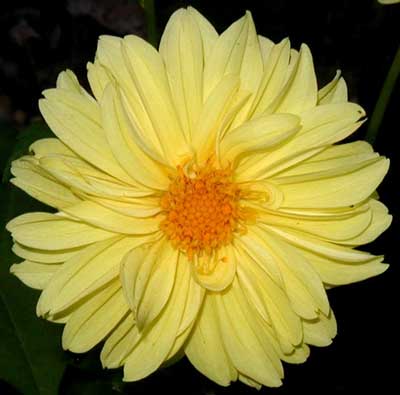
Lemony yellow dahlia.
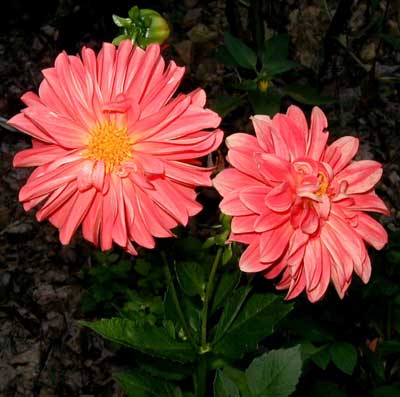
Salmony red dahlia.
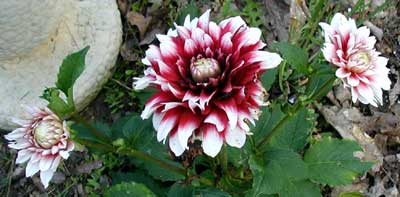
Deep purple and white variegated dahlia.
Lariope grass from North Carolina is about to bloom. The spike of light purple flowers will be opening soon. I hope the seeds will help to establish this plant as a border for this flower garden. In any case it seems that some of the plants have adapted to the conditions here in Pennsylvania.
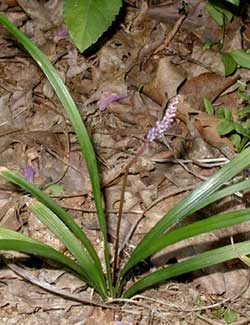
Lariope blooms in a spike of light purple flowers.
Statice is an unusual plant. The stems are rather flattened and sort of strange looking and they arise from a rosette of deeply cleft leaves at its base. The variety of colors makes statice a sought-after bloom for dried flower arrangements. In our small sampling we have yellow, blue, white and purple hues represented.
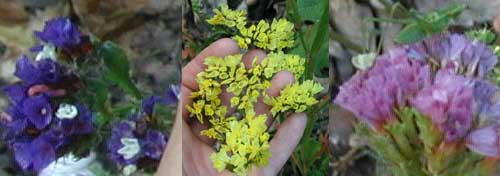
Statice blooms in many colors which makes it a nice flower for dried arrangements.
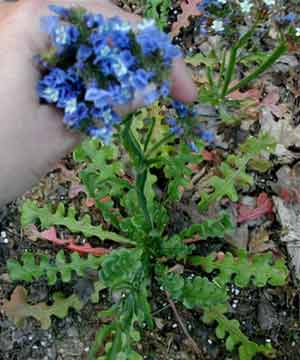
Spikes of statice flowers atop a basal rosette of green leaves.
The pink oxalis from North Carolina is doing well. Here you can see the five-petaled flowers and the leaves that clasp the stem from opposite sides.
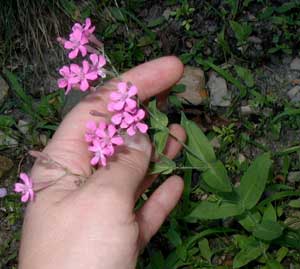
Pink flowering oxalis.
Gee, I was wondering why we don’t see any birds at the birdbath!
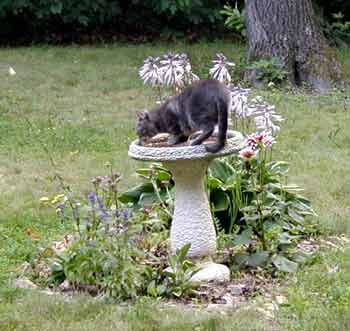
Greystokes taking a drink at the birdbath.
Help, my lariope has taken over how do I trim/cut it or thin it???
Hello Karen,
Lariope works great to fill in a small hill or other area you don’t want to mow, but it can certainly take over a flower bed! To thin it out I would suggest taking a shovel to it – just dig out a few shovels full to thin your batch of lariope. Trimming the shoots won’t do much good. You’ll have to get at the roots. Good luck!
Here’s some advice from another lariope gardener…
“It would take quite a whallop to be able to separate a lariope plant with
a shovel. Lariope spreads by tough underground rhizomes. If one wants to leave the ‘mother plant’ and get a few offspring from it, a better method
would be to take a sharp butcher’s knife or ax and cut away a few of the
outside offspring. No need to even take any dirt with it. Better method
might be to take up the entire plant (with shovel) and separate with knife
that way. The mother plant can then be replanted. All you need is a small
bit of root on each sprig to make a new plant.”
Thanks for that input, Squeaky!
Does lariope grow in CT – if planted on a steep hill, will it come back after the winter freeze?
Hello Brenda!
I planted some liriope last year and it came back this year here in PA. It experienced true winter weather here so the freeze should not have influenced it’s return.
Have you uncovered the area of any mulch or fallen leaves? Perhaps it needs a little more warmth or light to get going, especially if it’s on the shady side of the steep hill.
You might want to check with folks at the CT Botanical Society for the growing conditions in your area – http://www.ct-botanical-society.org/
Write back and let us know how it goes!
Hello
Great book. I just want to say what a fantastic thing you are doing! Good luck!
G’night
Hey!
I’ve just uploaded a demo version of my new herbal natural remedies database!
Please check it out if you are interested!
http://www.herbsinlatvia.com
I would really appreciate any comments and suggestions.
Forum covering different topics on herbal use and recipes will be opened soon.
See you all there!
Thanks! Warm regards!
Janina Veisola
Hi,
I am unfortunately the queen of lariope!
A few years ago I planted a border of lariope around my flower beds, now my yard is surrounded. These hardy plants can take a hard winter, a drought, poor soil,abuse by dogs, just about anything you can imagine. To devide, use a sharp bladed spade, cut in half straight down through the middle. You don’t have to be gentle. Each half will regrow when planted.
Thanks for chiming in about your tuff Lariope, Kathie. Some of us appreciate having plants that we can’t so easily destroy!
My liriope did not flower this year. It’s green so the plants seem to be doing ok. Perhaps our very dry weather interfered with the blooming. We tried not to water the flower beds as much as the vegetable garden, so we’ll see how things go next year.
Great pictures 🙂 I think your “Pink flowering oxalis” is actually a kind of phlox? Liriope pops up in random areas of my yard, but doesn’t always flower, I wonder why?
I’m going to transplant my Liriope and pour on some fish tank water, that should help 🙂
Thanks, Dog Art!
The pink-flowering “oxalis” does look like phlox with its 5 petaled flowers, but it is a small yard flower that blooms usually twice a year. After the spring blooming it may flower again in the fall. Actually, the leaf structure is all wrong for an oxalis – they have shamrock-type leaflets in threes instead of the opposite leaves that clasp the stems as you see here. Super! From now on I’ll call it the Meadow Phlox as the flower head is elongated and not as compact as the Garden Phlox.
As for the liriope some fertilization may help it flower. We keep lots of fish tanks and regularly pour on the dirty water for a nitrogen-rich fertilizer. Good luck with yours. Let us know how it works out!
I have grown statice plants for many summers . It’s only been in the last two that I can’t get them to bloom . They have lots of green leaves, but the blooms haven’t developed in the last two seasons. Lack of enough sun, wrong soil ph???
Hi Ginny,
If your statice is in the same location year after year, it may be time for a little fertilizer. It would be best to add fertilizer in spring to encourage growth then, not just before autumn sets in. Mulching with organics is great too, especially before winter. Doing both will likely help bring on next year’s blooms.
Good luck!
Thanks! I’ll try that next year.
The pink flowering oxalis is actually silene armeria
Good find! Thank you so much for letting us know the correct identification for this plant. It has since died.